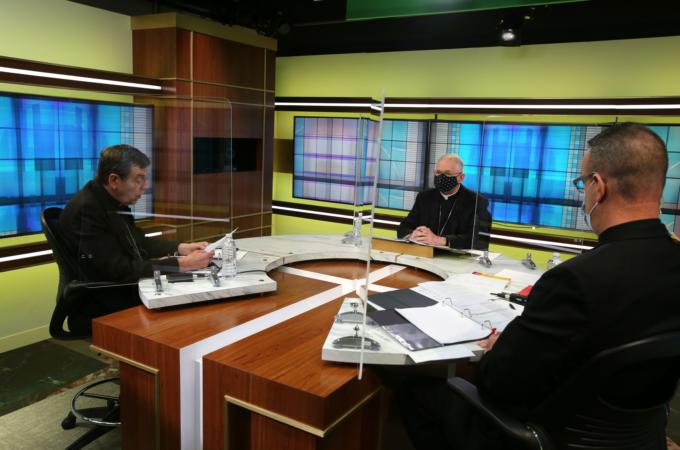Lights! Camera! Plenary!: What goes into planning an all-online USCCB meeting
WASHINGTON (CNS) -- There's a theater adage that if you have a lousy dress rehearsal, you're likely to have a great performance.
Well, what if you had four dress rehearsals -- twice as many as you had anticipated -- and the outlook was still dodgy?
The adage still apparently held true for the U.S. Conference of Catholic Bishops' fall general meeting Nov. 16-17, held virtually due to the pandemic.
Considering the many complexities that had to be worked out, the entire two-day meeting worked out smoothly, said Amy Newlon, manager for meetings and events at the USCCB.
When the USCCB spring meeting was canceled, the thinking emerged that the U.S. bishops might not be able to gather in person in November either, according to Newlon.
"We started forming a working group back as early as May looking at all the implications," she told Catholic News Service in a Nov. 18 phone interview. "We started looking at what other bishops' conferences were doing" in lieu of in-person meetings.
"The actual decision didn't get made until August, but we were working on it, knowing that was probably a likely thing knowing the state of Maryland had a ban on conventions," Newlon said. For most of the 2000s, the USCCB has held its fall general meeting in Baltimore.
Next steps included considering what items the USCCB Administrative Committee, the governing body of the USCCB, might want to defer, she said, given that bishops would not likely want to sit in front of a computer screen for eight hours a day on three consecutive days.
"We were also investigating what would be the best virtual way to accomplish certain things," Newlon said. One example was voting. It was decided that mail ballots would work best when voting for a chairman and chairmen-elect of various USCCB committees, and that email would work when voting on action items presented during the plenary sessions.
But to run the meeting, the USCCB sent requests for proposals to production companies that were "very centered on their ability to make this event interactive," Newlon said. "We know this couldn't be a webinar."
She added, "We knew we needed the ability for them (individual bishops) to come to the camera to make interventions." The USCCB chose the St. Louis-based firm Switch, which had come recommended by the St. Louis-based Catholic Health Association.
But even to get this far, the bishops had to vote to suspend their bylaws requiring in-person meetings, Newlon told CNS.
With USCCB associate general secretary Theresa Ridderhoff, Newlon said they worked "very much in close collaboration" with Communications, USCCB Chief Communications Officer James Rogers, the USCCB Office of General Counsel, and with Siobhan Verbeek of the bishops' Secretariat for Doctrine office "advising us on all of our canonical issues."
But to arrange everything on-camera, a lot of behind-the-camera work had to be done.
It was decided to use two studios. In the USCCB's TV studio at its Washington headquarters, Archbishop José H. Gomez of Los Angeles, USCCB president, and Archbishop Allen H. Vigneron of Detroit, USCCB vice president, would sit at the "anchor desk" with Msgr. J. Brian Bransfield, the outgoing USCCB general secretary. But Switch's own studio in St. Louis was used to coordinate events.
Most bishops made prerecorded presentations for the USCCB meeting, but a few prelates, due to the small size of the USCCB studio, sat in other offices in the building with a camera trained on them, ready to respond to bishops' questions should they arise.
For one thing, nobody in the Washington studio knew which bishops were "raising their hands" virtually to speak on a discussion topic. That information had to be fed to Archbishop Gomez. And they had to be called on to speak in order, so that the "lower third" -- that part of the screen that identifies the person on screen -- would be correct.
There were only a handful of glitches. In a couple of instances, a bishop who wished to speak had neglected to unmute himself. Every so often, at the conclusion of a bishop's remarks, his last few words were repeated, albeit at a lower volume. One time, a bishop spoke out of order, but Archbishop Gomez got to the bishop who had been passed over next.
When the time comes that the bishops can meet in person again, there may be a few lessons that could be carried over from the all-online format, Newlon said. One is keeping time to ensure that the meeting does not run overtime.
Another, Newlon added, could be the use of a TelePrompTer for bishops to make their presentations: "That did seem to help some people, and it seemed to give them confidence for people who are giving presentations live from a podium, instead of looking up and out into the audience. I thought some of the committee reports went incredibly well."



















